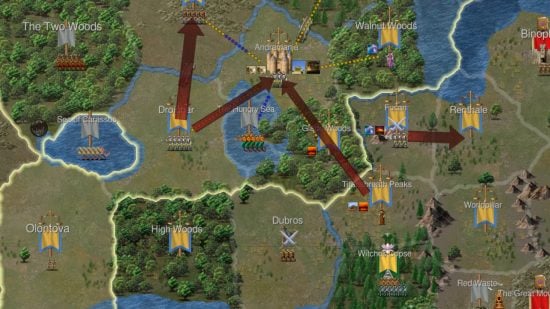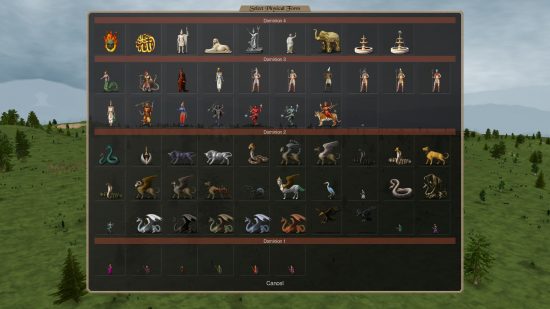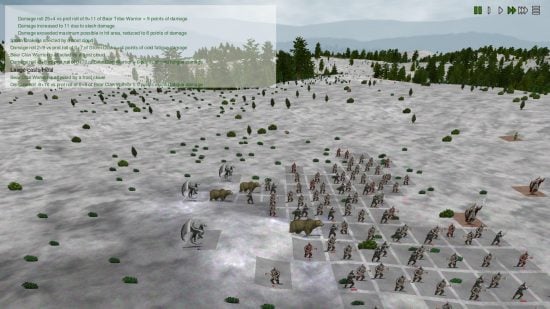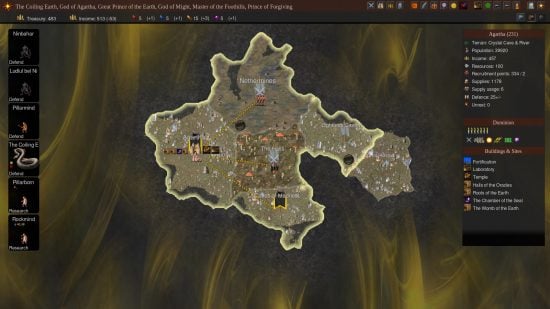Our Verdict
You won't find a better fantasy battle simulator than Dominions 6. The immense variety and depth on offer in Dominions just gets better when its paired with the quality of life changes and gameplay tweaks Illwinter has added for this latest installment.
It’s quite daunting to review a game like Dominions 6: Rise of the Pantokrator. This strategic wargame is a title of immense complexity that players will still be discovering new things about for years to come. It’s the next installment in a strategy series that has devoured more than 1,500 hours of my free time, a game full of myth and magic where vast armies compete to crown a new God.
It’s also not that different, at first glance, to Dominions 5. The two person team at Illwinter has an iterative style of game development, where they update the previous title a bunch before upping tools on a new engine and fresh features for the next installment. That’s to say that if you’ve played a Dominions game before, then much will be familiar in Dominions 6, and you may be wondering: should I buy this next game, or stick with what I have?
That’s getting ahead of ourselves a little, though. Before we dive into the nitty gritty details, we must first cover exactly what Dominions 6 is all about. If you know this already, feel free to skip ahead ten paragraphs or so.

Dominions is a fantasy strategy game where you take on the mantle of a God-to-be, perhaps a monstrous bull, tremendous cyclops, or really cool rock. Your aim is to lead your chosen nation of worshippers, recruit brave warriors and powerful mages, and squish any other pretenders to God-dem until you are the undisputed champion.
Dominions 6 is a turn based game defined by enormous variety and flexibility, paired with a brilliant theme. It has over 80 nations to select from, hundreds of magic items and spells, and thousands of different units. It’s a game inspired by mythology, where the minotaurs, centaurs and sirens of Greek myth cross sword and hoof with the giants of Genesis, all bundled up with a healthy dollop of fiction.
To an extent, Dominions is a 4x game, but it’s all focused on that final X, exterminate. The beating heart of Dominions 6 is its incredibly detailed battle simulator. (How detailed? The individual wounds, xp, age, and kill count of each unit, from the mightiest deity to the tiniest ant is permanently tracked by the game.)
In Dominions, you plan turns and watch battles. Fights play out in a real time simulation without your input, basically like an autobattler. The strategy comes in planning and preparing for those battles, recruiting the right troops, mages and monsters, giving them the right orders, equipment, and spells before forces are joined; and picking your targets carefully.
It’s surprisingly easy to play, far more accommodating than other niche strategy games which I’ve bounced off in the past. And that’s mostly because while there are overwhelming options, there aren’t overwhelming systems.
This is a combat-focused wargame first and foremost, so if you’re all about nation building and peaceful improvement, it may not be for you. I’d even imagine that some people will buy Dominions 6 and find it too simplistic – systems like Diplomacy and Infrastructure are very rudimentary – bouncing off for the opposite reason.
But they’ll have only scratched the surface, for you get out of Dominions 6 what you put in. Finding strategies and synergies in this game brings the same joy of discovery as brewing decks for a TCG. You could focus on churning out massive armies of militia that you buff until their skin is hard as stone. You could make only elite troops and mages, summoning skeletal warriors to do most of your fighting for you. You could pin all your hopes on one massive dude with boots that let him step on people.
The options are near limitless, and allow room for experimentation and exploration. You might create stealthy raiding parties, seduce opposing commanders, or recruit hundreds of tiny cheap archers and enchant their weak bows to deal fire damage.
You could give a dozen disease resistant, stealthy undead a disease-causing amulet that messes up a rival’s economy without making your hostile intentions known. You could ensure your god’s blessing imbues holy troops with poison resistance, and then poison an entire battlefield. You could make a front line of exploding spirits.
In the late game, the options get truly ridiculous and apocalyptic in scale. You can pick an undead nation and then make time speed up so that everyone else ages and dies. You can snuff out the sun to give your bats and cave people an advantage. You can freeze the seas.
In multiplayer matches, where these tools are all being utilized fully (sadly the AI lacks the same creativity) and mixed in with plotting and backstabbing, à la classic board game Diplomacy, it’s a treat to play. I’d describe it as a game of rock paper scissors with an unlimited smorgasbord of tools. Against the most insurmountable odds, there is always something clever you could try. It may not work, but you’ll have fun with the attempt.
While outwardly it has little in common with Dwarf Fortress, I would class Dominions 6 in the same category: as a game that creates stories, and rewards thinking outside the box. (Also a game many will find it more fun to hear about than to play, I’d wager.)
Finally, the setting of Dominions 6 excites my imagination, with different mythologies from around the world woven together into one tale. The game’s nations are split into three ages and as well as dictating the tone of each match (later ages have more humans, blood magic, and better armaments) this tells a story about the progression of different empires.
For instance, the wild men and centaurs of Pangaea discover civilization, the Aztec-inspired Mictlan swears off human sacrifice then gets taken over by toad people who reinstate it, and the game’s Rome stand-in has its own zombie apocalypse and splinters into offshoots.
This is all true for Dominions 6, but it was also true about Dominions 5 and 4 (and, I presume, the earlier games as well). And if there’s one criticism you could level at the new game in the series, it’s that it lacks a clearly defined USP.
Dominions 6 does not really have one headline feature to shout about the way 4 did with the ‘Thrones’ capture point system and 5 did with its real time battles and customisable blesses. That is not to say that nothing has changed, quite the contrary. It’s hard to be sure but I’d tentatively venture that Dominions 6 might be the largest step up for the series.
Because there are some big changes, and there’s also a ton of small ones. There’s a whole new Magic path, Glamour, to explore, for starters, whose addition is best compared to when Pokémon added the Fairy type. It’s all fey illusions and tricks, borrowing some spells that Air had in past games, as well as getting plenty of new ones.
Air has lots of new additions to make up for Glamour’s poaching, too. This one change affects what strategies are on offer for every nation that uses Air or has been given Glamour magic.
There are also changes that make exploration more of a factor, including fog of war which obscures the map, and an underground cavern plane that’s great for cave nations. As someone who already dislikes dealing with the fiddly logistics of the game’s aquatic battles, I’m not sure how popular it is going to be to have large numbers of provinces always drenched in darkness, but it makes the game world more varied, and, tantalizingly, it appears modders may be able to add new planes of their own.

Basic diplomacy with binding non-aggression packs will be a game changer in singleplayer. And I almost forgot to mention the addition of six new nations, from tribes led by animal shapeshifters to Muspelheim fire giants, to little horned men who ride birds.
As well as the big changes, there’s tweaks to battles that shift the whole feel of the game. Dominions 6 is rebalanced to make armies larger and mages a little less dominant. At first I was disappointed by this, loving the spectacle of Dominions’ magic system, but after playing the game for many hours I think it’s probably my favorite change.
In Dominions 5, by the mid game, magic was hitting armies like a blender. Now, with mages more costly and devastating battlefield magic harder to reach, you’ll be relying more on your troops, with vaster armies backed up by mages.
Decisions you make about your fighting forces will be more important for longer and won’t boil down to: ‘What will survive and not run away for long enough that my wizards can kill everyone?’. I do worry that as a result of the change, single player AI is not investing in enough mages right now, perhaps put off by the steeper price tag.
There’s a great deal of new details affecting battles too, which makes them feel more varied and interesting. For instance, mounted troops are separated from their mounts, so you’ll see horses lose their riders and run off or knights fall to the ground and fight on. Morale is very different too. Individual units can peel off and flee when they get scared, rather than the all-or-nothing system that had whole squadrons fight on or turn tail.
Terrain can obstruct, be destroyed, and have other effects, and there are even indoor battles. When you send assassins after opposing commanders, they might be in a pub with their mates. That last point is typical of Illwinter’s insane attention to detail: it’s a change no one would have thought to request, but one that makes the world feel much more alive.
The other big area of improvement is accessibility. There are major UI and quality of life updates that provide more detailed information to players, or streamline existing features.
For instance, when you cast a ritual on a distant province there’s a graphic showing where it’s going. Your magic item arsenal is neatly organized, your nation’s economy is broken down for you. And there’s a lobby system for quickly organizing online games. This is all very handy stuff, and some are features that fans have been clamoring after for ages.

Finally, I’ll say that more so than new features, Dominions 6 seems to have an enormous number of tweaks. There are new spells and new bless effects, and loads of spells have been changed. Many nations have been reworked, and tons of systems operate just a little bit differently than they did before. Old staple strategies have been nerfed, and there will doubtless be new ones to discover.
As a lapsed Dominions 5 player, Dominions 6 saw familiar gears clicking into place as I engaged with a puzzle with a thousand pieces: a puzzle that has now been utterly scrambled Dominions is so complex that just changing one element of the game can have hundreds of little knock-on effects, and it seems like Illwinter has altered dozens.
Dragging my stubborn brain back seven years, I don’t think there was as much to relearn between Dominions 4 and Dominions 5 as there is with this release, though it could just be that my understanding of the whole game was less nuanced. Either way, having tasted Dominions 6, I definitely wouldn’t go back.
So back to my question at the start of this review, should you buy Dominions 6? For most people, the answer is a confident yes. If you’re new to the series and want to check it out then this is certainly the best Dominions game available, and the price is more or less the same as Dominions 5.
If you’re a multiplayer player then you’ll probably want to move over because the wider MP community is almost certain to make the leap. If you’re a lapsed singleplayer player like me, then Dominions 6 breathes fresh life into the game. The only type of strategy fan I can think who might better be served sticking with Dominions 5 is one who purely enjoys the single player, and still has a ton left to enjoy in the previous game.
Otherwise, Dominions 6 gets my wholehearted recommendation. I’m itching to wrap this review up so that I can go and play some more.






